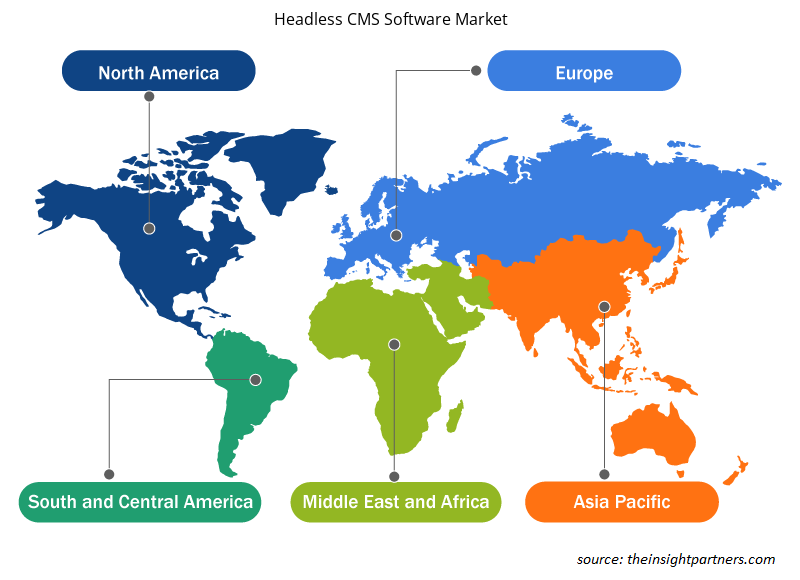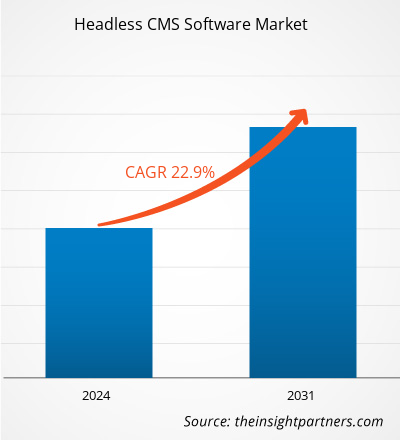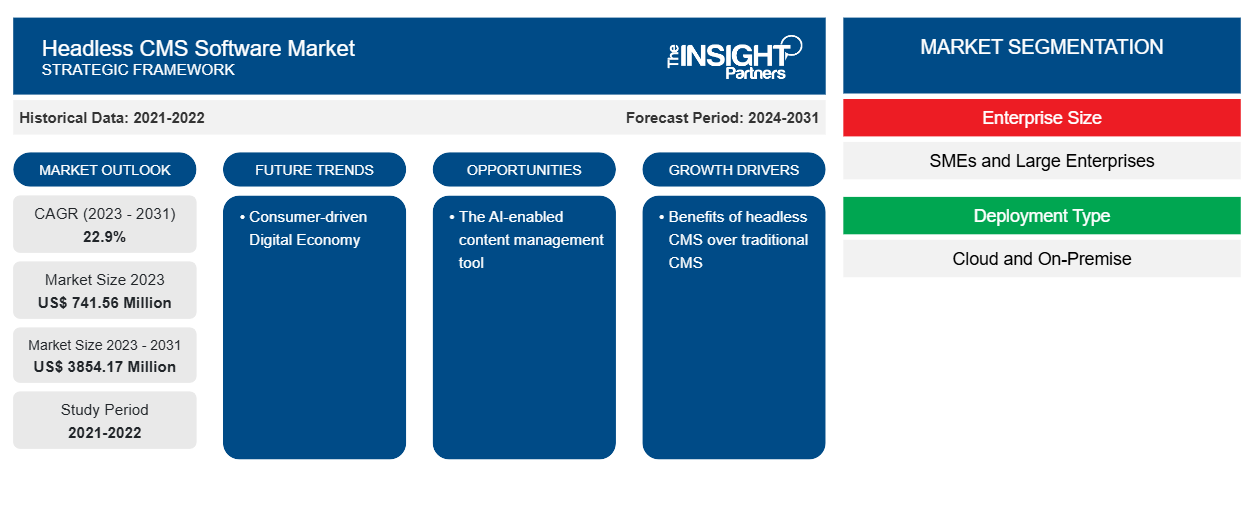من المتوقع أن يصل حجم سوق برامج إدارة المحتوى بدون واجهة إلى 3854.17 مليون دولار أمريكي بحلول عام 2031 من 741.56 مليون دولار أمريكي في عام 2023. ومن المتوقع أن يسجل السوق معدل نمو سنوي مركب بنسبة 22.9٪ في الفترة 2023-2031. ومن المرجح أن يظل النمو السريع للمحتوى الرقمي وتبني التقنيات المستندة إلى السحابة مفتاحًا لاتجاهات سوق برامج إدارة المحتوى بدون واجهة.
تحليل سوق برامج إدارة المحتوى بدون رأس
يؤدي تبني برامج إدارة المحتوى بدون واجهة مستخدم إلى تحسين الأمان والأداء، وقد تعزز برامج إدارة المحتوى بدون واجهة مستخدم المرونة وقابلية التوسع والتوطين. هذا العامل هو الذي يحرك سوق برامج إدارة المحتوى بدون واجهة مستخدم. إن الطلب على برامج إدارة المحتوى بدون واجهة مستخدم عبر مختلف الصناعات في البلدان المتقدمة والنامية يدفع نمو سوقها.
نظرة عامة على سوق برامج إدارة المحتوى بدون رأس
يُعد نظام إدارة المحتوى بدون واجهة مستخدم نظام إدارة محتوى يسمح لك بفصل الواجهة الأمامية عن الواجهة الخلفية. يعمل نظام إدارة المحتوى كمستودع للمحتوى في هذه البنية، ويمكن نشر المحتوى على منصات متعددة عبر واجهة برمجة التطبيقات. تتمثل إحدى الفوائد الأساسية لنظام إدارة المحتوى بدون واجهة مستخدم في مرونته. في نظام إدارة المحتوى التقليدي، تكون الواجهة الأمامية والخلفية مرتبطتين بشكل لا ينفصم، لذا فإن التغييرات التي تطرأ على الواجهة الأمامية تؤثر على التغييرات التي تطرأ على الواجهة الخلفية، والعكس صحيح. في نظام إدارة المحتوى بدون واجهة مستخدم، يتم فصل الواجهة الخلفية عن الواجهة الأمامية، مما يسمح للشركات بتغيير محتواها وتطبيقاتها على الواجهة الأمامية دون التأثير على الواجهة الخلفية.
قم بتخصيص هذا التقرير ليناسب متطلباتك
ستحصل على تخصيص لأي تقرير - مجانًا - بما في ذلك أجزاء من هذا التقرير، أو تحليل على مستوى الدولة، وحزمة بيانات Excel، بالإضافة إلى الاستفادة من العروض والخصومات الرائعة للشركات الناشئة والجامعات
-
احصل على أهم اتجاهات السوق الرئيسية لهذا التقرير.ستتضمن هذه العينة المجانية تحليلاً للبيانات، بدءًا من اتجاهات السوق وحتى التقديرات والتوقعات.
محركات وفرص سوق برامج إدارة المحتوى بدون رأس
الاقتصاد الرقمي الذي يقوده المستهلك لصالح السوق
لقد أصبح الاقتصاد الرقمي الذي يقوده المستهلك هو المكون الأساسي لاستراتيجيات التجارة الرقمية عبر الصناعات. يصل المستهلك إلى الشركات أو العلامات التجارية عبر عدد من القنوات. وهذا يشجع الشركات على تحديث استراتيجية تجربتها الرقمية لتقديم تجارب متعددة القنوات حقيقية لتلبية متطلبات التخصيص للعملاء. يجب أن يكون المحتوى الذي يركز على العملاء مخصصًا وديناميكيًا ويتم تقديمه بسرعة كبيرة. مع فوائد المرونة والقدرة على التوسع والتخصيص، يمكن لبرامج إدارة المحتوى بدون واجهة مساعدة الشركات على تحسين تجربة العملاء.
فوائد نظام إدارة المحتوى بدون رأس مقارنة بنظام إدارة المحتوى التقليدي
يوفر نظام إدارة المحتوى بدون واجهة مستخدم مرونة أكبر مقارنة بأنظمة إدارة المحتوى التقليدية، حيث يجب إنشاء المحتوى مرة واحدة مع نظام إدارة المحتوى بدون واجهة مستخدم. ويمكن توزيعه على قنوات وأجهزة متعددة، بما في ذلك مواقع الويب والساعات الذكية وتطبيقات الأجهزة المحمولة وأجهزة إنترنت الأشياء وغيرها. يوفر نظام إدارة المحتوى بدون واجهة مستخدم المحتوى عبر واجهات برمجة التطبيقات حيث يتم تحميل الصفحات بسرعة أكبر وكفاءة أكبر، بينما مع نظام إدارة المحتوى التقليدي، تتطلب كل صفحة تشغيل عرض تقديمي من جانب الخادم، مما يتسبب في بطء وقت التحميل. يعد نظام إدارة المحتوى بدون واجهة مستخدم أكثر أمانًا من نظام إدارة المحتوى التقليدي لأنه يستخدم تقنيات سحابية متقدمة ولا يعرض الخادم الخلفي للإنترنت. وبالتالي، فإن هذه الفوائد العديدة لنظام إدارة المحتوى بدون واجهة مستخدم مقارنة بنظام إدارة المحتوى التقليدي تؤدي إلى نمو سوق برامج نظام إدارة المحتوى بدون واجهة مستخدم.CMS offers greater flexibility over traditional CMS, as with the headless CMS, the content needs to be created once. It can be distributed to multiple channels and devices, including websites, smartwatches, mobile apps, devicesCMS delivers content via APIs where the pages load at a greater speed more efficiently, whereas with the traditional CMS, each page requires trigger a server-side-render, which causes slow load time. Headless CMS is more secure than traditional CMS as they use advanced cloud-native technologies and they don’t expose the backend server to the internet. Thus, such several benefits of headless CMS over traditional CMS lead to the headless CMS software market growth.
تقرير تحليل تجزئة سوق برامج إدارة المحتوى بدون رأس
كانت القطاعات الرئيسية التي ساهمت في اشتقاق تحليل سوق برامج إدارة المحتوى بدون رأس هي نشر الحبر، وحجم المنظمة، ونوع المراقبة، والصناعة.
- من خلال النشر، يتم تقسيم السوق إلى محلي وسحابي. ومن المتوقع أن ينمو قطاع السحابة بأعلى معدل نمو سنوي مركب.
- بناءً على حجم المؤسسة، يتم تقسيم السوق إلى الشركات الصغيرة والمتوسطة الحجم والشركات الكبيرة. ومن المتوقع أن ينمو قطاع الشركات الصغيرة والمتوسطة الحجم بأعلى معدل نمو سنوي مركب.
تحليل حصة سوق برامج إدارة المحتوى بدون رأس حسب المنطقة الجغرافية
ينقسم النطاق الجغرافي لتقرير سوق برامج CMS بدون رأس بشكل أساسي إلى خمس مناطق: أمريكا الشمالية، ومنطقة آسيا والمحيط الهادئ، وأوروبا، والشرق الأوسط وأفريقيا، وأمريكا الجنوبية/أمريكا الجنوبية والوسطى.
من المتوقع أن تنمو منطقة آسيا والمحيط الهادئ بأعلى معدل نمو سنوي مركب. يؤدي انتشار تكنولوجيا الحوسبة السحابية في المنطقة إلى نمو سوق المنطقة. تعمل الشركات الصغيرة والمتوسطة الحجم المتنامية في المنطقة على تغذية الطلب على حلول البرامج في المنطقة، مما يدفع إلى استخدام تكنولوجيا المراقبة الاصطناعية . يؤدي التحول الرقمي في الاقتصادات الناشئة مثل الهند والصين إلى اعتماد حلول المراقبة الاصطناعية في مختلف صناعات المستخدم النهائي.
رؤى إقليمية حول سوق برامج إدارة المحتوى بدون رأس
لقد قام المحللون في Insight Partners بشرح الاتجاهات والعوامل الإقليمية المؤثرة على سوق برمجيات إدارة المحتوى بدون رأس طوال فترة التوقعات بشكل شامل. يناقش هذا القسم أيضًا قطاعات سوق برمجيات إدارة المحتوى بدون رأس والجغرافيا في جميع أنحاء أمريكا الشمالية وأوروبا ومنطقة آسيا والمحيط الهادئ والشرق الأوسط وأفريقيا وأمريكا الجنوبية والوسطى.

- احصل على البيانات الإقليمية المحددة لسوق برامج إدارة المحتوى بدون رأس
نطاق تقرير سوق برامج إدارة المحتوى بدون رأس
| سمة التقرير | تفاصيل |
|---|---|
| حجم السوق في عام 2023 | 741.56 مليون دولار أمريكي |
| حجم السوق بحلول عام 2031 | 3854.17 مليون دولار أمريكي |
| معدل النمو السنوي المركب العالمي (2023 - 2031) | 22.9% |
| البيانات التاريخية | 2021-2022 |
| فترة التنبؤ | 2024-2031 |
| القطاعات المغطاة |
حسب حجم المؤسسة
|
| المناطق والدول المغطاة |
أمريكا الشمالية
|
| قادة السوق وملفات تعريف الشركات الرئيسية |
|
كثافة اللاعبين في سوق برامج إدارة المحتوى بدون رأس: فهم تأثيرها على ديناميكيات الأعمال
يشهد سوق برامج إدارة المحتوى بدون رأس نموًا سريعًا، مدفوعًا بالطلب المتزايد من المستخدم النهائي بسبب عوامل مثل تفضيلات المستهلك المتطورة والتقدم التكنولوجي والوعي المتزايد بفوائد المنتج. ومع ارتفاع الطلب، تعمل الشركات على توسيع عروضها والابتكار لتلبية احتياجات المستهلكين والاستفادة من الاتجاهات الناشئة، مما يؤدي إلى زيادة نمو السوق.
تشير كثافة اللاعبين في السوق إلى توزيع الشركات أو المؤسسات العاملة في سوق أو صناعة معينة. وهي تشير إلى عدد المنافسين (اللاعبين في السوق) الموجودين في مساحة سوق معينة نسبة إلى حجمها أو قيمتها السوقية الإجمالية.
الشركات الرئيسية العاملة في سوق برمجيات CMS بدون رأس هي:
- شركة أجيليتي
- زبدةCMS
- شركة كونتينتفول المحدودة
- شركة كونتنتستاك
- دوت سي ام اس ذ.م.م
- شركة هايغراف المحدودة
إخلاء المسؤولية : الشركات المذكورة أعلاه ليست مرتبة بأي ترتيب معين.

- احصل على نظرة عامة على أهم اللاعبين الرئيسيين في سوق برمجيات إدارة المحتوى بدون رأس
أخبار سوق برامج إدارة المحتوى بدون رأس والتطورات الأخيرة
يتم تقييم سوق برامج إدارة المحتوى بدون رأس من خلال جمع البيانات النوعية والكمية بعد البحث الأولي والثانوي، والذي يتضمن منشورات الشركات المهمة وبيانات الجمعيات وقواعد البيانات. فيما يلي قائمة بالتطورات في السوق:
- في يونيو 2023، تهدف aurastride، أحدث إضافة إلى مجموعة منتجات Vsourz، إلى إحداث تغيير جذري في صناعة السفر بإطلاقها كمنصة CMS بدون واجهة مستخدم متطورة. من المقرر أن يعمل هذا الحل المبتكر على تحويل الطريقة التي تدير بها شركات السفر المحتوى وتقدم تجارب مخصصة، مع تقديم تكامل سلس مع منصة Moonstride SAAS لصناعة السفر التي تحظى بتقدير كبير. (المصدر: Moonstride، بيان صحفي، 2023)
تقرير سوق برامج إدارة المحتوى بدون رأس يغطي المنتجات المطلوبة
يوفر تقرير "حجم سوق برمجيات إدارة المحتوى بدون رأس وتوقعاته (2021-2031)" تحليلاً مفصلاً للسوق يغطي المجالات التالية:
- حجم السوق والتوقعات على المستويات العالمية والإقليمية والوطنية لجميع قطاعات السوق الرئيسية التي يغطيها النطاق
- ديناميكيات السوق مثل المحركات والقيود والفرص الرئيسية
- الاتجاهات المستقبلية الرئيسية
- تحليل مفصل لقوى PEST/Porter الخمس وSWOT
- تحليل السوق العالمي والإقليمي الذي يغطي اتجاهات السوق الرئيسية واللاعبين الرئيسيين واللوائح والتطورات الأخيرة في السوق
- تحليل المشهد الصناعي والمنافسة الذي يغطي تركيز السوق، وتحليل خريطة الحرارة، واللاعبين البارزين، والتطورات الأخيرة
- ملفات تعريف الشركة التفصيلية
- التحليل التاريخي (سنتان)، سنة الأساس، التوقعات (7 سنوات) مع معدل النمو السنوي المركب
- تحليل PEST و SWOT
- حجم السوق والقيمة / الحجم - عالمي، إقليمي، بلد
- الصناعة والمنافسة
- مجموعة بيانات إكسل
التقارير الحديثة
تقارير ذات صلة
شهادات العملاء
سبب الشراء
- اتخاذ قرارات مدروسة
- فهم ديناميكيات السوق
- تحليل المنافسة
- رؤى العملاء
- توقعات السوق
- تخفيف المخاطر
- التخطيط الاستراتيجي
- مبررات الاستثمار
- تحديد الأسواق الناشئة
- تحسين استراتيجيات التسويق
- تعزيز الكفاءة التشغيلية
- مواكبة التوجهات التنظيمية























 احصل على عينة مجانية ل - سوق برامج إدارة المحتوى بدون رأس
احصل على عينة مجانية ل - سوق برامج إدارة المحتوى بدون رأس